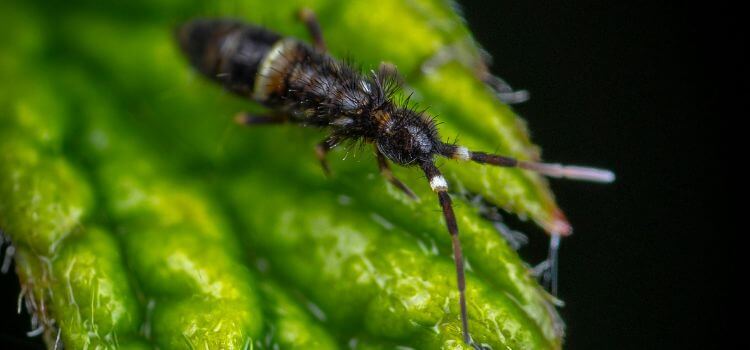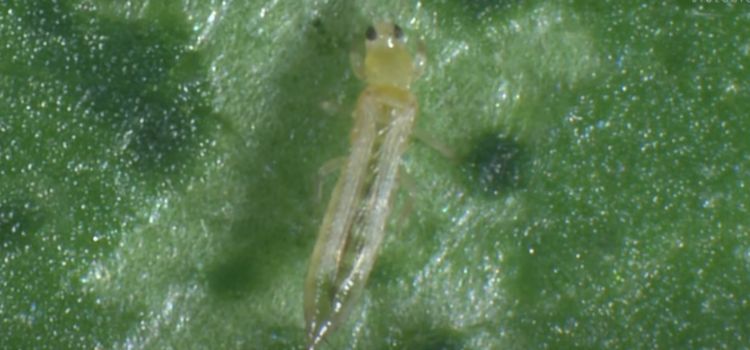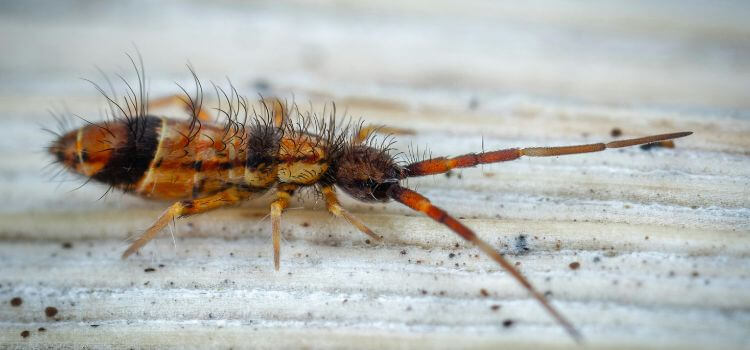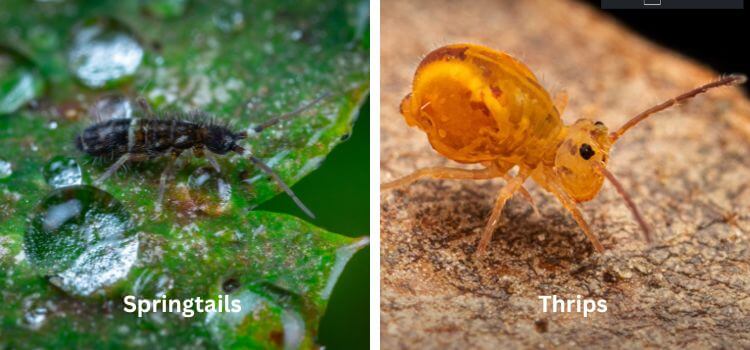As an Amazon Associate, I earn from qualifying purchases.
Springtails and thrips are small insects that often infest plants. They differ in appearance, behavior, and damage caused.
Springtails are tiny, wingless insects known for their jumping ability. They thrive in moist environments and feed on decaying organic matter. Thrips, on the other hand, are slender, winged insects that feed on plant sap, causing significant damage to crops and ornamental plants.
Identifying these pests is crucial for effective pest management. While springtails are generally harmless to plants, thrips can transmit plant diseases and cause visible damage, such as stippling and deformities. Proper identification and targeted treatment can help protect your plants from these pests. Recognizing the differences between these insects ensures appropriate control measures and healthier plants.
Springtails And Thrips
Springtails are tiny insects. They jump high using a tail-like structure. Springtails live in soil and leaf litter. They help break down organic matter. Springtails are harmless to plants and humans. They thrive in moist environments.

Thrips are small, slender insects. They feed on plants by sucking their juices. Thrips can cause damage to crops. They leave behind silvery scars on leaves. Thrips can spread plant diseases. Controlling them is important for healthy plants.
Physical Characteristics
Springtails are tiny, wingless insects with elongated bodies and furcula for jumping. Thrips are slender, winged insects with fringed wings and piercing mouthparts.
Springtail Features
Springtails are tiny insects. They are usually 1-2 millimeters long. Their bodies are soft and segmented. Springtails have a special tail called a furcula. This tail helps them jump. They come in many colors like white, gray, and purple. Springtails have six legs and short antennae. They live in moist places like soil and leaf litter.
Thrip Features
Thrips are very small insects. They measure about 1-2 millimeters long. Their bodies are slender and have fringed wings. Thrips can be yellow, brown, or black. They have six legs and long antennae. Thrips are known for their piercing-sucking mouthparts. They live on plants and can damage them.
Behavior And Habits
Springtails thrive in moist environments, feeding on decaying matter. Thrips, on the other hand, damage plants by sucking their juices. Both pests are tiny but have distinct behaviors and habits.
Springtail Behavior
Springtails are tiny insects. They are often found in damp places. They love moist soil and decaying leaves. These insects can jump very high. This helps them escape from predators. Springtails are harmless to plants. They feed on fungi and organic matter.
Thrip Behavior
Thrips are small and slender insects. They can be found on plants. These insects suck the sap from leaves and flowers. This can damage plants and reduce growth. Thrips can also spread plant diseases. They are often seen in greenhouses and gardens. Control measures are necessary to protect plants.

Habitat Preferences
Springtails prefer damp environments. They thrive in moist soil, leaf litter, and decaying wood. You can find them in gardens, forests, and greenhouses. Springtails love areas with high humidity. They often gather near water sources.
Thrips prefer plants and flowers. They are common in gardens, fields, and greenhouses. Thrips often hide under leaves and petals. They feed on plant sap. Thrips can damage crops and flowers.
Impact On Plants
Springtails usually eat dead plant material. This helps in decomposing organic matter. They rarely harm living plants. Sometimes they may nibble on roots. This rarely causes significant damage.
Thrips are known to be harmful to plants. They suck out plant juices. This can cause discoloration and deformities. They also spread plant diseases. Thrips can make plants weak and unhealthy.
Identification Tips
Distinguishing springtails from thrips involves examining their movement and physical features. Springtails jump when disturbed, while thrips crawl. Noting these differences helps in accurate identification.
Spotting Springtails
Springtails are tiny insects. They are usually less than 6 mm long. These insects jump high to escape danger. Springtails are often found in moist areas. They have a unique, forked tail called a furcula. This tail helps them jump. Springtails may appear white, gray, or light brown.
Spotting Thrips
Thrips are very small insects. They are usually less than 1.5 mm long. Thrips can be yellow, brown, or black. They have fringed wings. Thrips often damage plants by sucking their juices. You may see silver streaks on leaves. This can be a sign of thrips.
Control Methods
Springtails love moist environments. Drying out the soil helps reduce their population. Use a dehumidifier to keep indoor air dry. Avoid overwatering your plants. Clean up any organic debris around your home. This reduces their hiding spots.
Thrips can damage plants by sucking out their juices. Use sticky traps to catch them. Spray insecticidal soap on affected plants. This helps kill thrips. Remove any infested leaves and dispose of them. Introduce natural predators like ladybugs to your garden. This helps keep thrips under control.
Preventive Measures
Springtails love moist environments. Keep your home dry to prevent them. Fix any leaks quickly. Use a dehumidifier in damp areas. Clean up any spilled water or food immediately. Store food in airtight containers. Remove decaying plant material from your garden. Regularly vacuum and clean your home. Seal any cracks or gaps in walls and floors. Ensure proper ventilation in basements and attics.
Inspect plants before bringing them indoors. Thrips often hide in flowers and leaves. Use sticky traps to catch adult thrips. Prune infested plant parts and dispose of them. Maintain a clean garden and remove dead leaves. Introduce natural predators like ladybugs. Avoid over-watering plants. Thrips thrive in humid conditions. Regularly check and treat plants with insecticidal soap. Rotate crops to reduce thrip populations.

Frequently Asked Questions
How To Tell Springtails From Thrips?
Springtails have a unique, forked tail used for jumping. Thrips are tiny, slender insects with fringed wings. Springtails are often found in moist environments, while thrips prefer plants.
How Do I Know If I Have Springtails?
You might have springtails if you see tiny, jumping insects near moist areas. Check for them around sinks, bathtubs, and plant soil. They often appear in damp, dark places. Use a magnifying glass to identify their small, white or gray bodies.
What Does A Thrip Infestation Look Like?
A thrip infestation appears as silver streaks or speckles on leaves. You might also see tiny black feces spots.
Why Do I Suddenly Have Springtails?
Springtails appear due to excessive moisture and organic matter. They thrive in damp environments like bathrooms and basements. Reducing humidity levels can help control them. Seal cracks and fix leaks to prevent their entry.
Conclusion
Understanding the differences between springtails and thrips is crucial for effective pest control. Identifying these tiny insects helps protect your plants. Both pests require specific strategies for management. Knowing their behavior and characteristics is key. Stay vigilant and proactive in your pest control efforts.
Keep your garden healthy and thriving.

